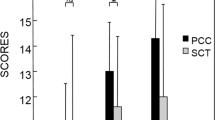Abstract
Context The PRACTICUM Institute has developed large-scale international programs of on-line continuing professional development (CPD) based on self-testing and feedback using the Practicum Script Concordance Test© (PSCT). Aims To examine the psychometric consequences of pooling the responses of panelists from different countries (composite panels) and the effect of increasing composite panel size. Method 97 cardiologists in Mexico answered a set of 62 PSCT cases/305 questions. A local panel was recruited in Mexico (n = 7). Other panelists were recruited in Argentina (n = 10) and Brazil (n = 11). Together they constituted a composite panel of 28 experts. Random panels of reference of increasing sizes (5, 10, 15, 20, and 25) were generated. Participants’ scores were computed for each panel sample. Units of analysis were means of participants’ scores per case. Discrimination, ranking and reliability of the scores obtained with each panel were estimated. Descriptive statistics, Pearson correlation coefficient, generalizability analysis, computation of Cronbach’s alpha were used in the analyses. Results Correlation coefficients between the local and the composite panels ranged from 0.951 to 0.981. Cronbach alpha coefficient values were above 0.85 for all panels. The value of the relative G coefficient from the generalizability analyses varied from 0.91 to 0.93, indicating very high and stable ranking of participants, though absolute value of scores increased with increasing composite panel size. Conclusions In CPD environments, and with panel members selected with the highest standards, composite panels can be used. Panels of all sizes yielded high psychometric qualities. Absolute scores should be interpreted with caution.

Similar content being viewed by others
References
Bursztejn, A. C., Cuny, J. F., Adam, J. L., Sido, L., Schmutz, J. L., de Korwin, J. D., et al. (2011). Usefulness of the script concordance test in dermatology. Journal of the European Academy of Dermatology and Venereology, 25, 1471–1475.
Cardinet, J., Johnson, S., & Pini, G. (2012). Applying generalisability theory using EduG. New York, London: Routledge, Taylor and Francis Group.
Charlin, B., & van der Vleuten, C. (2004). Standardized assessment of reasoning in contexts of uncertainty: the script concordance approach. Evaluation in the Health Professions, 27, 304–319.
Charlin, B., Brailovsky, C., Leduc, C., & Blouin, D. (1998). The Diagnosis Script Questionnaire: A new tool to assess a specific dimension of clinical competence. Advances in Health Sciences Education, 3, 51–58.
Charlin, B., Boshuizen, H. P., Custers, E. J., & Feltovich, P. J. (2007). Scripts and clinical reasoning. Medical Education, 41, 1178–1184.
Dory, V., Gagnon, R., Vanpee, D., & Charlin, B. (2012). How to construct and implement script concordance tests: insights from a systematic review. Medical Education, 46, 552–563.
Elstein, A. S. (1993). Beyond multiple-choice questions and essays: The need for a new way to assess clinical competence. Academic Medicine, 68, 244–249.
Fournier, J. P., Demeester, A., & Charlin, B. (2008). Script concordance tests: Guidelines for construction. BMC Medical Informatic Decision Making, 8, 18, http://www.biomedcentral.com/1472-6947/8/18.
Gagnon, R., Charlin, B., Coletti, M., Sauve, E., & van der Vleuten, C. (2005). Assessment in the context of uncertainty: How many members are needed on the panel of reference of a script concordance test?Medical. Education, 39, 284–291.
Gantelet, M. (2008). Impact du panel de référence sur les résultats d’un Test de Concordance de Script (TCS) développé en formation initiale des sages-femmes. Dissertation for the completion of a diploma of the Ecole des cadres sages-femmes. Dijon: Ecole de Cadres Sages-Femmes.
Hornos, E., Pleguezuelos, E. M., Brailovsky, C. A., Harillo, L. D., Dory, V., & Charlin, B. (2012). The Practicum Script Concordance Test: an online continuing professional development format to foster reflection on clinical practice. Journal of Continuing Education in the Health Professions, in press.
Norcini, J. J., & Shea, J. A. (1990). The effect of level of expertise on answer key development. Academic Medecine, 65(Suppl), S15–S16.
Norman, G. R. (1985). Objective measurement of clinical performance. Medical Education, 19, 43–47.
Sibert, L., Charlin, B., Corcos, J., Gagnon, R., Grise, P., & van der Vleuten, C. (2002). Stability of clinical reasoning assessment results with the Script Concordance test across two different linguistic, cultural and learning environments. Medical Teacher, 24, 522–527.
Acknowledgments
The authors would like to thank Leandro Harillo for his help in collecting the data and preparing this manuscript.
Author information
Authors and Affiliations
Corresponding author
Rights and permissions
About this article
Cite this article
Pleguezuelos, E.M., Hornos, E., Dory, V. et al. Script concordance testing in continuing professional development: local or international reference panels?. Adv in Health Sci Educ 18, 779–785 (2013). https://doi.org/10.1007/s10459-012-9427-3
Received:
Accepted:
Published:
Issue Date:
DOI: https://doi.org/10.1007/s10459-012-9427-3




